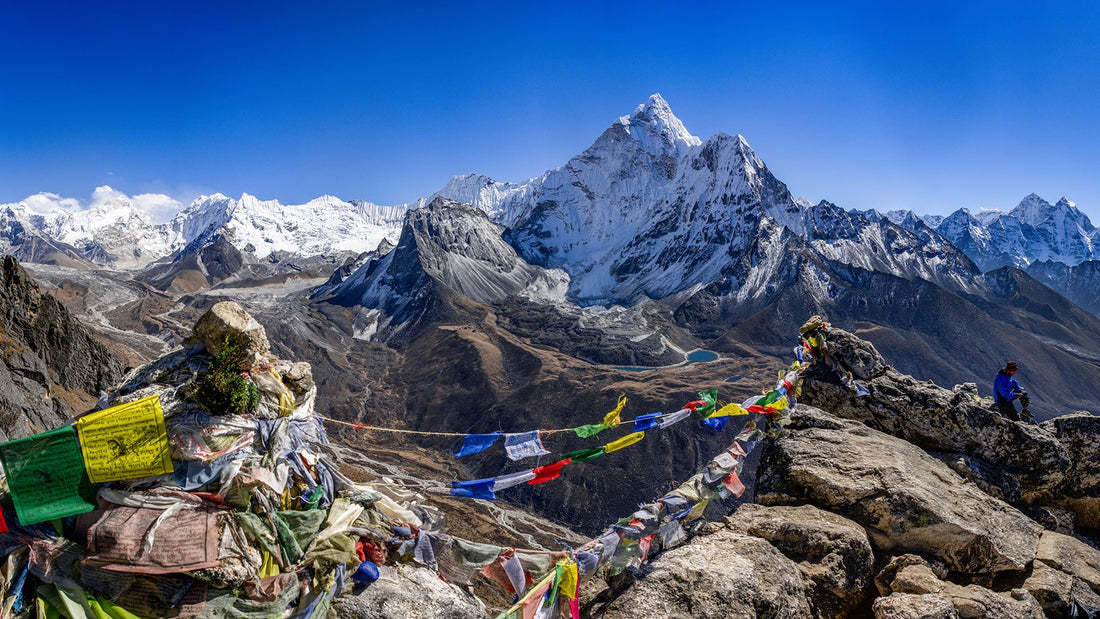
Where to go mountaineering in May
Share
The shift in seasons brings mountaineering back to northern America and Europe this month, but if you’re after higher and more remote mountaineering objectives then look a little further afield.
Here are our suggestions for where the best mountaineering can be found this month, but as always, you’ll need to check up to date information regarding access and logistics, particularly for those areas subject to geo-political tensions (and volcanic activity!). Here’s a little inspiration for the month of May. And if not this year, why not next?
North America
The short climbing season in Alaska gets going in May, with a range of challenges from huge alpine-style undertakings such as those found in the Ruth Gorge (with relatively easy fly-in access), to huge big wall rock routes on the Kichatna Spires. Of course, the most famous mountains is Denali (6194m) which is one of the Seven Summits and often said to be as tough as Everest because of the amount of load carrying required (and the inclement weather). For a wilder, more remote experience the Revelations Range has huge potential for exploratory routes with not a soul in sight.

Alaska’s Ruth Gorge in Denali National Park (Photo: mtnmichelle)
Further south (but arguable not much less remote) are Canada’s extensive Coast Mountains, which can require days of bush-whacking to reach the snow line. If you’ve not got the motivation for that, then the ‘Fourteeners’ (mountains over 14,000 feet i.e. 4267m) of Colorado, Washington and California are generally more accessible – climbing all of them will keep you going for years to come!
Asia
May is probably the highest profile month in the mountaineering calendar because of the ‘Everest effect’. It’s about the only mountain that makes mainstream press, and every year there seems to be some sort of controversy or new record set. Some say it’s a high altitude circus (and they might be right), but the one thing you can be sure of is that the highest point on earth is always going to attract attention. If crowds of people put you off, then the good news is there are thousands of other mountains where you can find solitude and adventure.
This month is when most summit bids are made on the highest mountains in Nepal, Tibet and India, providing the monsoon doesn’t arrive early. By early May the big expeditions on Everest, Lhotse and Makalu are usually keenly watching the forecasts waiting for a weather window, and trying to make sure camps, people and equipment are ready to go.
If you want to experience the grandeur of the Khumbu valley without entering ‘the death zone’, there are a number of so called ‘trekking peaks’ which offer a taste of high altitude climbing (and shouldn’t be underestimated). Island Peak, Mera Peak and Lobuche are good introductions to climbs of around 6000m altitude with lower technical difficulty, but they still involve steep snow and require decent warm gear. They all lie off the main trail to Everest Basecamp, which can get very busy with both trekkers and climbers but on the plus side you might get to rub shoulders with your climbing heroes over dinner in the tea houses.
For those wanting something with more technical terrain, Kyajo Ri (6186m) is in a less visited valley north of Namche Bazaar, and has a satisfyingly ‘pointy’ summit with a mixture of glacier, steep snow and rock on the ascent. For even more technical climbing, slightly higher again, there’s also the fantastic Ama Dablam (6812m) which can’t be missed from the upper Khumbu valley.

Ama Dablam above the Khumbu valley on the approach to Everest (Photo: Jan Gruber)
For climbers with more experience at altitude looking to break the 7000m threshold, then Himlung Himal(7125m) in the Annapurna region near the Tibetan border is becoming quite popular. This is in part thanks to it being objectively quite safe, and technically fairly straight forward which makes it a good place to test your tolerance of very high altitude. The same is true of the slightly higher in Annapurna IV (7525m).
If you’re serious about aiming for the world’s highest peaks, then there are ‘only’ 14 summits which lie above 8000m. May is usually the month that climbers attempt to summit Everest (8848m), Lhotse (8516m), Makalu (8485m), Annapurna (8091m) and Dhalugiri (8167m) in Nepal. There’s also Kanchenjunga (8586m) which lies on the border between Nepal and India, and over in Tibet are Shishapangma (8013m) and Cho Oyu (8188m). The remaining 8000ers are in the Karakorum range in Pakistan, and are usually climbed later in the year.
South America
Despite being autumn in the southern hemisphere, May is the start of the main climbing season for the volcanic peaks of the Cordillera Occidental that spans the borders of Peru, Bolivia and Chile. These are generally more moderate climbs, which explains why evidence of ascents made by the Inca has been found as high as 6000m on peaks like Nevado Coropuna in Peru.
The more impressive technical alpine style mountains of Bolivia and Peru are generally climbed in the winter season, as the weather is more stable with less precipitation and clearer (but colder conditions). There are hundreds of summits between 5000m and 6800m, some of which you’ll have heard of, like Alpamayo (the ‘most beautiful mountain in the world’) and Siula Grand (made famous by Joe Simpson’s ‘Touching the Void’), and many you wont.
The advantage of climbing in these areas is the speed and simplicity of access from major cities like La Paz and Huarez, which makes it possible to climb a couple of 6000m peaks in not much more than a 2 week trip.
Australasia
The equatorial region is technical in the ‘drier’ season during May (a relative term, it’s still likely to be tropical and somewhat wet!). Carstenz Pyramid is arguably the most technical of the Seven Summits, with plenty of rocky scrambling terrain and often a tyrolean traverse required to reach the top. Over in Malaysia, there are plenty of other interesting rocky peaks including Mount Kinabalu on the island of Borneo which are climbable.
Europe
Depending on how snowy the winter has been, and when the temperatures start to warm up, May can be the start of the summer alpine season in the European Alps but can also be the best month for ski touring. Either way there are masses of options, you just have to decide where to base yourself (a challenge in itself!).
So there you have it, there’s plenty of mountain adventures to be had around the world in May.
